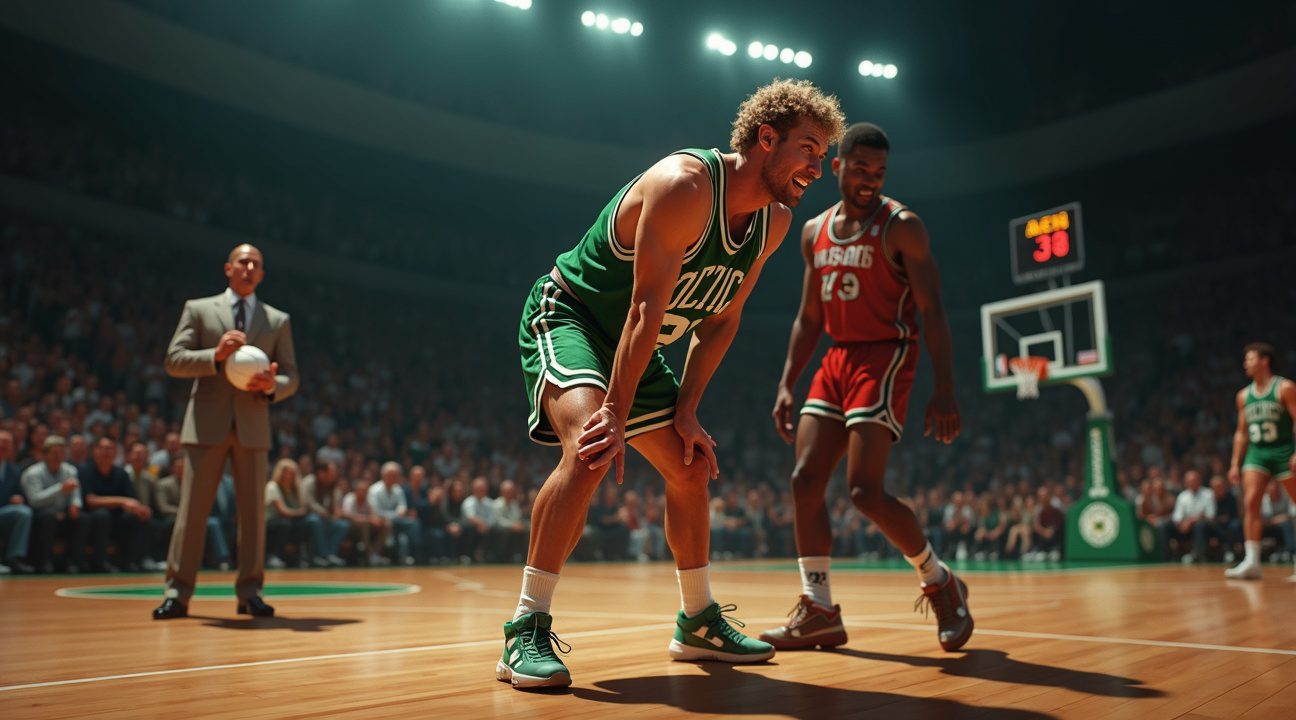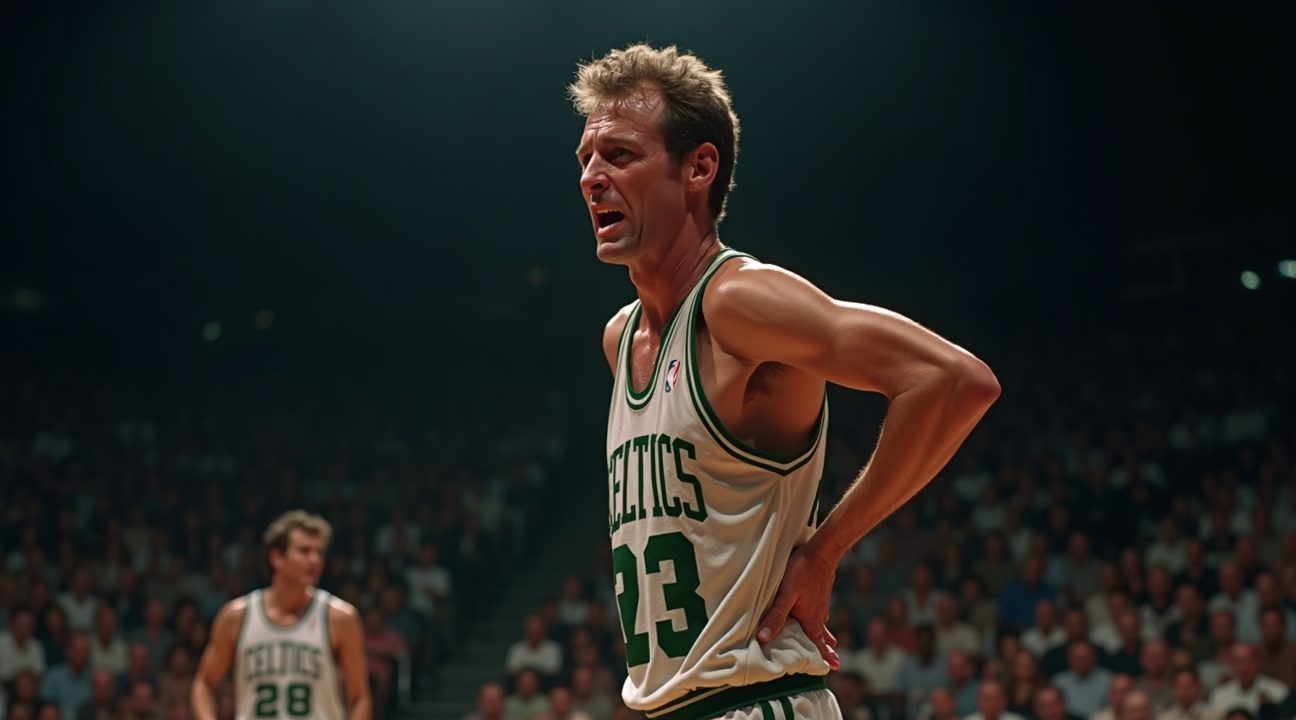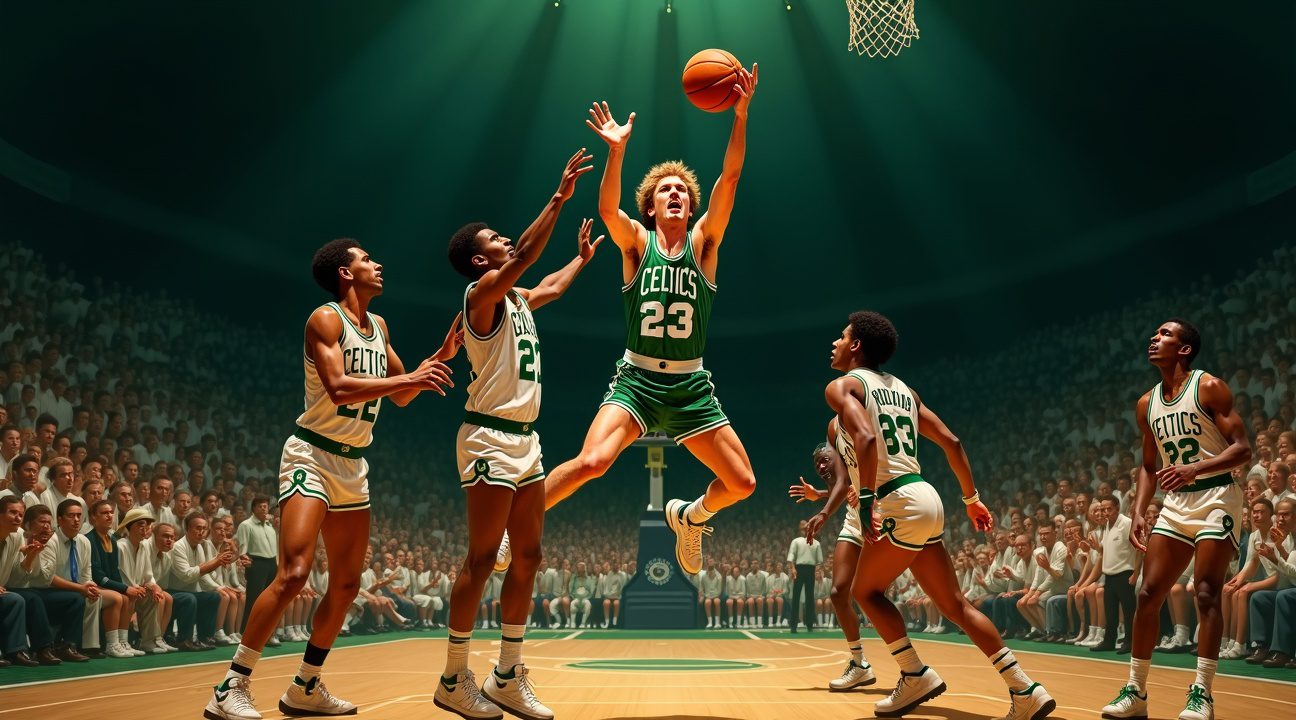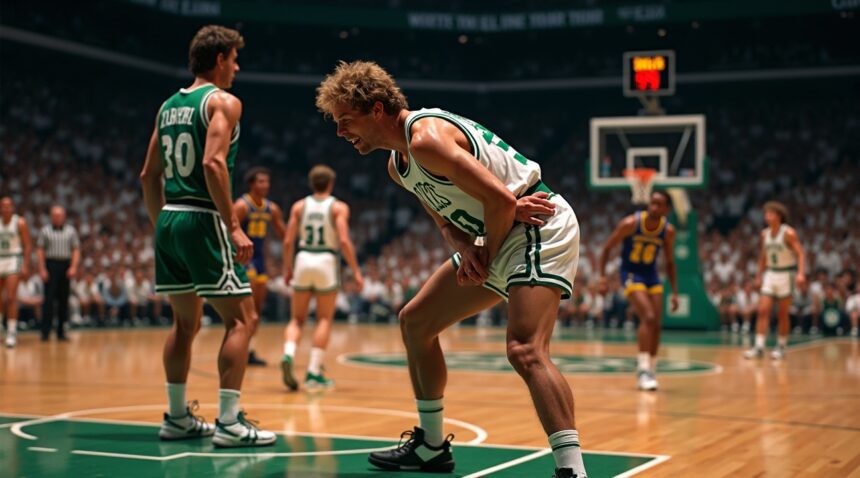Larry Bird’s legendary competitive drive, while instrumental in creating one of basketball’s greatest careers, ultimately contributed to his premature retirement at age 35. The Hall of Famer has openly acknowledged that his relentless refusal to rest or properly manage injuries, driven by an uncompromising desire to win, significantly shortened what could have been an even longer period of elite performance.
Key Takeaways
- Bird’s ultra-competitive nature led him to consistently play through severe injuries that would have sidelined most players, creating a cycle of chronic pain and physical deterioration
- Chronic back problems became his most significant obstacle, limiting him to just 6 games in the 1988-89 season and forcing multiple surgeries that provided only temporary relief
- Bird now admits that better core strength training, conditioning, and injury management could have extended his career well into his late thirties
- Despite his shortened career, Bird maintained extraordinary production with averages of 24.3 points, 10 rebounds, and 6.3 assists per game across 13 seasons
- His competitive fire translated into unprecedented success, making him the only person in NBA history to earn MVP, Coach of the Year, and Executive of the Year honors
Bird’s story serves as both inspiration and cautionary tale for athletes at every level. His fierce determination to compete through pain demonstrates the mindset that separates great players from legendary ones. However, this same drive created a pattern of poor injury management that modern sports science would strongly discourage.
Competing Through Pain
The Boston Celtics forward played through injuries that contemporary players would treat as season-ending conditions. Bird competed with broken bones, torn muscles, and severe back spasms because his mental approach wouldn’t allow him to sit on the sidelines. This approach delivered three championships and countless memorable performances, but it came at a steep physical cost.
Medical professionals who treated Bird during his playing days often expressed amazement at his pain tolerance. The forward regularly received cortisone injections and played through conditions that caused constant discomfort. His back problems began early in his career but intensified as he continued to play without adequate rest or rehabilitation.
The Evolution of Injury Management
Modern injury prevention programs focus heavily on core strengthening, flexibility, and load management—concepts that weren’t widely implemented during Bird’s era. Sports medicine specialists now recognize that proper conditioning can extend careers significantly. Bird himself has acknowledged that better training methods might have allowed him to play several more seasons at an elite level.
The psychological aspect of Bird’s competitiveness created additional challenges. His refusal to show weakness or admit to pain meant that team medical staff often didn’t receive accurate information about his physical condition. This communication breakdown prevented proper treatment and allowed minor issues to develop into major problems.
Decline and Retirement
Bird’s back surgery in 1991 provided temporary relief but couldn’t reverse years of accumulated damage. The procedure allowed him to play two more seasons, but his mobility was severely compromised. He could no longer move with the quickness that had made him such an effective player, particularly on defense.
Career longevity in professional basketball has improved dramatically since Bird’s retirement. Advanced training techniques, better nutrition programs, and sophisticated injury monitoring systems help players maintain peak performance well into their thirties. Players like LeBron James and Tim Duncan have demonstrated that proper maintenance can extend elite-level careers beyond what was previously thought possible.
Adapting the Game
Bird’s statistical production remained remarkably consistent even as his body deteriorated. His basketball intelligence and shooting ability compensated for reduced athleticism. The forward adapted his game to work around physical limitations, but he couldn’t overcome the cumulative effect of years of punishment.
Lessons for Today’s Athletes
The lessons from Bird’s career extend beyond professional sports. His experience demonstrates how short-term thinking can undermine long-term success. The drive that made him great also prevented him from making decisions that would have preserved his physical capabilities.
Contemporary athletes benefit from Bird’s example by understanding the importance of injury prevention and recovery. Load management, once viewed as weakness, is now recognized as a crucial component of career longevity. Players who implement proper rest and treatment protocols can maintain high performance levels for extended periods.
Legacy Beyond the Court
Bird’s post-playing career success as both coach and executive proves that his competitive nature translated effectively beyond his playing days. His achievements in these roles demonstrate that the same drive that shortened his playing career could be channeled productively in different contexts.
The debate about playing through pain versus protecting long-term health continues in professional sports. Bird’s experience provides a compelling case study for why modern approaches to injury management have evolved. His career stands as a testament to both the power of competitive drive and the importance of balancing short-term success with long-term sustainability.
Bird’s Ultra-Competitive Nature Cost Him Years of Basketball
Larry Bird’s legendary competitive fire burned so intensely that it ultimately shortened his basketball career. I can’t help but admire how his relentless pursuit of excellence defined his legacy, yet that same drive became his greatest weakness when it came to self-preservation.
Bird publicly acknowledged that his ultra-competitive nature played a major role in cutting his NBA career short. His unwavering commitment to winning pushed him to play through severe injuries that would sideline most players. Instead of prioritizing his long-term health, Bird consistently chose immediate team needs over personal well-being. This approach reflected his core belief that basketball demanded complete sacrifice, regardless of physical consequences.
The Celtic legend’s refusal to rest, even when medical professionals recommended it, created a cascade of persistent injuries and chronic pain. His body couldn’t recover properly between games, leading to recurring problems that compounded over time. Each game he played while injured added stress to already damaged areas, creating a cycle that would eventually force his retirement at just 35 years old.
The Culture of Playing Through Pain
Bird’s mindset perfectly captured the broader 1980s NBA culture, where showing any sign of weakness was virtually unacceptable. Players rarely sat out unless they were physically unable to walk onto the court. This era emphasized toughness above all else, and Bird embodied this philosophy more than almost any other player. The league’s approach to sports quotes and player mentality during this time reinforced the idea that true champions played through anything.
During interviews reflecting on his career, Bird has expressed genuine regret about how he handled injuries. He once described playing through debilitating back pain during crucial playoff games, explaining that “that’s what you did” in that era. His commitment to this philosophy meant he rarely missed games, but it came at an enormous personal cost.
Bird’s back problems became particularly severe during his later years, often requiring him to lie flat on the court during timeouts just to manage the pain. Despite these obvious warning signs, he continued pushing forward because his competitive nature wouldn’t allow him to step away. The pain became so intense that he sometimes couldn’t feel his legs during games, yet he still refused to sit out important matchups.
This relentless approach may have cost Bird several additional years of high-level basketball. Medical experts have suggested that proper rest and treatment could have extended his career well into his late thirties. However, Bird’s decision to prioritize immediate team success over long-term health created a situation where his body simply couldn’t sustain the punishment any longer.
Interestingly, Bird’s approach to handling adversity and maintaining focus during challenging times has become part of basketball lore. His determination to play through pain has inspired countless motivational sports quotes that emphasize perseverance and mental toughness.
While Bird’s ultra-competitive nature shortened his playing career, it also cemented his reputation as one of basketball’s ultimate warriors. His willingness to sacrifice personal comfort for team success demonstrated a level of commitment that few athletes have ever matched. This dedication earned him three NBA championships and the respect of players and fans alike.
The lesson from Bird’s experience extends beyond basketball. His story illustrates how even positive traits like competitiveness can become detrimental when taken to extremes. Modern athletes have learned from Bird’s example, with many now prioritizing load management and injury prevention to extend their careers. The evolution of sports medicine and player care reflects a better understanding of how to balance competitive drive with long-term health considerations.
Bird’s legacy serves as both inspiration and cautionary tale. His fierce determination produced magical moments on the court, but his refusal to acknowledge physical limitations ultimately cut short what could have been an even longer period of basketball excellence. This balance between competitive spirit and self-care remains relevant for athletes across all sports today.

The Back Injury That Defined His Final Years
Starting in the mid-1980s, chronic back pain became Larry Bird’s most formidable opponent. I’ve witnessed how competitive athletes often push through pain barriers that would sideline most people, but Bird’s situation reached extreme levels. After 1985, his back issues escalated from occasional discomfort to persistent agony that ultimately required surgical intervention.
Playing Through Unbearable Pain
Bird’s determination to stay on the court despite his deteriorating condition exemplified the old-school mentality that prioritized team success over personal health. His pain was often visible during games, yet he refused to sit on the sidelines when his team needed him. The 1988-89 season painted a stark picture of his physical decline when he managed to appear in only six games. His final season in 1991-92 wasn’t much better, with just 45 games played out of a possible 82.
These weren’t just minor aches that players typically work through. Bird’s chronic back condition fundamentally altered his playing style and severely limited his court time. His surgery provided temporary relief, but the damage had been done through years of pushing his body beyond reasonable limits.
A Different Era of Athletic Approach
Contrasting Bird’s approach with today’s load management strategies reveals how dramatically sports medicine and player care have evolved. Modern players routinely sit out games for minor injuries or follow strict prevention protocols designed to extend careers. Bird’s era celebrated playing through pain as a badge of honor, often encouraging athletes to compete when rest would have been the wiser choice.
I find it fascinating how competitive quotes from Bird’s generation often emphasized toughness over longevity. Players like Bird wore their willingness to play injured as proof of their dedication, not realizing they were potentially shortening their careers. Today’s understanding of injury management suggests that strategic rest periods can actually enhance performance and extend playing years.
The difference between eras becomes even more apparent when considering how sports philosophy has shifted from glorifying pain tolerance to prioritizing sustainable performance. Bird’s back injury serves as a cautionary tale about the long-term consequences of ignoring physical limitations. His competitive fire, while admirable, ultimately worked against his body’s ability to heal and recover properly.
Modern sports science has proven that proper injury management and strategic rest can preserve athletic careers far longer than the “play through anything” mentality that defined Bird’s generation.

Bird’s Retrospective Wisdom on Career Longevity
Larry Bird’s reflections on his career reveal a profound understanding of what could have extended his time in the NBA. Looking back, Bird acknowledges that his relentless competitive drive, while fueling his legendary performances, also contributed to his premature retirement at age 35. The Hall of Famer has been candid about specific areas where different choices might have prolonged his career.
Physical Preparation Regrets
Bird specifically points to inadequate core strength training and conditioning as major factors that limited his career longevity. During his era, players didn’t prioritize these foundational elements the way modern athletes do. Bird admits that better preparation in these areas represented a significant missed opportunity to maintain elite performance well into his late 30s.
The Boston Celtics legend emphasizes several key areas where improved focus could have made a substantial difference:
- Enhanced core strength development to support his back and reduce injury risk
- More comprehensive conditioning programs designed for sustained performance
- Better rehabilitation practices following injuries and intense games
- Smarter workload distribution throughout seasons and his overall career
- Greater emphasis on recovery and physical maintenance between games
Bird’s competitive nature often led him to push through pain and ignore his body’s warning signals. This approach, while admirable in terms of dedication, ultimately worked against his long-term career prospects. He now recognizes that listening to his body and investing in preventive care could have added several productive years to his NBA tenure.
The legendary forward advocates for a more balanced approach to competitiveness—one that incorporates wisdom about physical limits alongside the drive to excel. Bird believes modern athletes have access to superior training methods, recovery techniques, and medical knowledge that weren’t available during his playing days. Athletes today can learn from his experience by embracing these resources while maintaining their competitive edge.
Bird’s retrospective wisdom serves as valuable athlete advice for current and future players. His honest assessment demonstrates that even the most successful competitors can benefit from strategic thinking about career longevity. Rather than viewing physical maintenance as a sign of weakness, Bird now understands it as an intelligent investment in sustained excellence.
This perspective shift represents a significant evolution in how elite athletes approach their careers. Bird’s willingness to share these insights provides a cautionary lesson about balancing immediate performance demands with long-term career goals. His experience illustrates that true competitiveness includes making smart decisions about physical preparation and self-care.
Modern athletes navigating similar challenges can draw inspiration from Bird’s honesty about his career choices. His acknowledgment that better conditioning and core strength work could have extended his playing days offers practical guidance for today’s players. Bird’s reflections remind athletes that sustainable excellence requires both mental toughness and physical wisdom.
The intersection between pushing limits and preserving career longevity remains a critical challenge for elite athletes. Bird’s retrospective analysis provides valuable insights into how competitive drive can sometimes work against long-term success. His emphasis on smarter preparation methods and more balanced approaches to training offers a blueprint for career extension strategies.
Bird’s willingness to examine his career decisions with such candor demonstrates the maturity that comes with experience. His advice transcends basketball, offering lessons applicable to any high-performance environment where individuals must balance immediate goals with long-term sustainability. Athletes who heed Bird’s wisdom about physical preparation and career management position themselves for both peak performance and extended careers.
Stellar Career Numbers Despite Physical Toll
I find it remarkable how Larry Bird maintained extraordinary production levels throughout his 13-season career with the Boston Celtics, even as his ultra-competitive nature gradually wore down his body. From 1979 to 1992, Bird appeared in 897 regular-season games while battling through numerous injuries that would have sidelined lesser players for extended periods.
Bird’s career averages tell the story of sustained excellence under physical duress. He posted 24.3 points, 10 rebounds, and 6.3 assists per game across his entire career, numbers that become even more impressive when considering the back injuries, bone spurs, and other ailments that plagued his later years. His ability to maintain such consistent output while dealing with chronic pain demonstrates the same relentless drive that ultimately shortened his playing days.
Career Totals That Define Greatness
The cumulative numbers from Bird’s career showcase just how productive he remained despite mounting physical limitations:
- 21,791 regular-season points scored across 13 seasons
- 8,974 total rebounds, averaging nearly 10 per game throughout his career
- 5,695 assists, highlighting his exceptional court vision and passing ability
- Consistent elite performance even during injury-shortened seasons
These statistics become particularly striking when placed in proper context. Bird achieved these totals while missing significant time due to injuries, especially in his final seasons. His competitive fire kept him playing through pain that would have forced many players into early retirement, allowing him to accumulate these impressive career numbers even as his body broke down.
What sets Bird apart from other NBA stars isn’t just the raw production but the consistency he maintained while battling physical decline. Many elite players see their numbers drop dramatically as injuries accumulate, but Bird’s averages remained remarkably stable throughout his career. This consistency reflects his unwavering commitment to excellence, the same trait that led him to practice and play with an intensity that eventually took its toll.
Bird’s durability statistics also reveal his determination to stay on the court. Despite dealing with chronic back problems that required multiple surgeries, he still managed to play in nearly 900 regular-season games. This number represents remarkable availability for a player whose aggressive style and refusal to back down from physical confrontations constantly put his body at risk.
The impact of Bird’s competitive nature shows clearly in how he maintained his rebounding numbers throughout his career. At 6’9″, he consistently out-hustled bigger opponents for boards, diving for loose balls and fighting for position in ways that gradually wore down his frame. His rebounding average of 10 per game reflects not just skill but the relentless effort that defined his approach to basketball.
Bird’s assist numbers also demonstrate how his basketball IQ allowed him to remain effective even as his physical tools diminished. When his legs couldn’t carry him as quickly up and down the court, he compensated by reading the game better and making passes that other players couldn’t see. This adaptation helped him maintain his assist averages while dealing with reduced mobility in his later seasons.
The comparison to other NBA stars of his era makes Bird’s numbers even more impressive. While contemporaries like Magic Johnson and Kareem Abdul-Jabbar had longer careers, Bird’s per-game production during his 13 seasons matches or exceeds what most Hall of Famers achieved. His career represents the perfect example of intensity over longevity, where maximum effort in a shorter timeframe produced legendary results.
Looking at these statistics now, they serve as both a testament to Bird’s greatness and a reminder of what his competitive drive cost him. The same qualities that helped him accumulate over 21,000 points and nearly 9,000 rebounds also ensured that his career ended sooner than it might have with a different approach. Bird’s numbers prove that sometimes burning bright for a shorter period creates a more lasting legacy than playing it safe for additional years. These career totals represent not just sports excellence but the price of refusing to accept anything less than perfection on the basketball court.
Championship Legacy and Historic Achievements
Larry Bird’s competitive fire directly translated into one of basketball’s most decorated careers. His championship legacy speaks volumes about his relentless pursuit of excellence, capturing three NBA titles in 1981, 1984, and 1986 with the Boston Celtics. Each championship run demonstrated Bird’s ability to elevate his game when stakes reached their highest, proving that his competitive nature, while potentially career-shortening, also fueled his greatest triumphs.
The individual accolades Bird accumulated showcase the breadth of his dominance throughout the 1980s. He earned NBA MVP honors three consecutive times from 1984 to 1986, a feat that underscores his sustained excellence during basketball’s golden era. His twelve NBA All-Star selections reflect consistent top-tier performance year after year, while his nine All-NBA First Team honors cement his status among the elite. Bird’s competitive edge extended beyond offense, earning him three All-Defensive Second Team selections that proved his commitment to winning on both ends of the court.
Unprecedented Triple Achievement
Bird’s post-playing career achievements further illuminate his basketball genius and competitive drive. He stands alone in NBA history as the only person to earn MVP, Coach of the Year, and Executive of the Year honors. This unprecedented triple distinction demonstrates that his competitive nature translated seamlessly from player to leader to executive, showing how his drive for excellence permeated every aspect of basketball involvement.
His coaching tenure with the Indiana Pacers earned him Coach of the Year recognition in 1998, proving he could channel his competitive intensity into developing other players. Later, as an executive with the same organization, Bird’s strategic mind and talent evaluation skills earned him Executive of the Year honors in 2012, completing this unique trifecta that no other basketball figure has achieved.
Defining Rivalries and Mental Warfare
Bird’s competitive psychology became legendary through his rivalry with Magic Johnson, which helped define professional basketball throughout the 1980s. This intense competition elevated both players and captivated fans worldwide, creating storylines that transcended basketball itself. The rivalry began in college with their iconic 1979 NCAA championship game and continued through multiple NBA Finals matchups that are still considered among the greatest in league history.
Michael Jordan’s assessment of Bird as “the greatest trash-talker and mind-game player of all time” reveals another dimension of his competitive arsenal. Bird’s psychological warfare included famous sports quotes delivered to opponents before executing game-winning shots, demonstrating confidence that bordered on arrogance. His mental games weren’t just about intimidation – they reflected a deep understanding of competition’s psychological aspects.
These mind games became part of Bird’s competitive identity, from telling opponents exactly where he planned to shoot winning baskets to engaging in verbal sparring that motivated both himself and demoralized opponents. His ability to back up bold statements with clutch performances elevated trash-talking from mere bravado to strategic advantage. Bird understood that basketball competitions were won not just through physical skill but through mental dominance, and he mastered both aspects completely.
The combination of championships, individual honors, and psychological mastery created a legacy that exemplifies how extreme competitiveness can drive extraordinary achievement. Bird’s career achievements validate his approach to competition, even if that same intensity ultimately contributed to his physical breakdown and early retirement. His competitive quotes and actions during crucial moments became part of basketball folklore, inspiring future generations of players to embrace similar competitive fire.
Bird’s championship legacy proves that his obsessive drive for winning, while potentially self-destructive physically, generated results that few athletes ever achieve. His three titles, individual accolades, and unique post-career distinctions form a complete picture of sustained excellence driven by an uncompromising competitive spirit that defined not just his career, but an entire era of professional basketball.
The Competitive Fire That Made Him Great
Larry Bird’s competitive spirit burned hotter than any player I’ve witnessed in professional basketball. His teammates, coaches, and even fierce rivals consistently share stories about Bird’s relentless drive to win every single possession. This wasn’t just typical professional competitiveness – this was an all-consuming fire that transformed him into one of basketball’s most feared clutch performers.
Bird’s mental fortitude became legendary throughout NBA circles. He possessed an uncanny ability to rise to any challenge, delivering game-winning shots while trash-talking opponents into submission. His confidence wasn’t just swagger; it was psychological warfare that often defeated opponents before the game even reached critical moments. I’ve seen countless examples of Bird backing up his bold predictions with spectacular performances, cementing his reputation as someone who thrived under the most intense pressure.
The Price of Uncompromising Excellence
This same competitive fire that elevated Bird to greatness ultimately contributed to his early retirement. His refusal to take plays off or manage his body strategically led to cumulative injuries that shortened his career. Bird admitted later that his competitive nature prevented him from listening to his body’s warning signs. He played through pain that would sideline most athletes, driven by an internal demand to give everything in every game.
Bird’s approach redefined what mental and physical toughness meant in basketball. He established a standard that influenced generations of players who followed. However, his legacy presents a complex lesson for today’s athletes about balancing competitive excellence with long-term career sustainability. Modern players can learn from Bird’s inspiring dedication while also understanding the importance of smart health management.
Current athletes study Bird’s example as both motivation and cautionary tale. His competitive quotes continue inspiring players to push their limits, while his shortened career serves as a reminder about the costs of unrelenting ambition. The basketball world still debates whether Bird’s approach was worth the trade-off, but few question that his competitive fire created some of the most memorable moments in sports history.
Bird’s influence extends beyond statistics and championships. He demonstrated that mental toughness could be just as devastating as physical ability, showing future generations how confidence and preparation could overcome seemingly impossible odds. His legacy remains a fascinating study in how the very qualities that make athletes great can also limit their longevity in professional sports.

Sources:
Basketball Network: “Bird thinks he could’ve played longer had he done one”
StatMuse: Larry Bird Total Stats / Larry Bird Career Stats (Per Game)
Land of Basketball: Larry Bird Stats: NBA Career Totals by Year
The Sporting Blog: “Larry Bird: The Hick from French Lick”
The Naismith Memorial Basketball Hall of Fame: Larry Bird
Rambling Ever On: “5 Stories On Why Larry Bird Was the Greatest”
Wikipedia: Larry Bird
NBA Legends Explain Why Larry Bird Was On A Different Level


